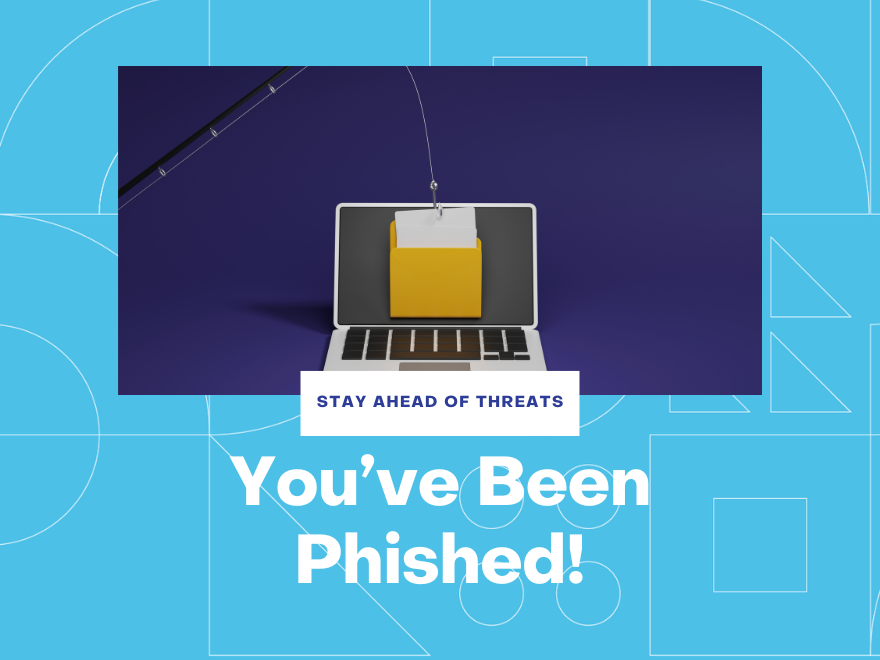
You’ve been Phished…
Have you ever encountered “spam” emails cluttering your inbox?
Yes?
Those emails are classed as a phishing attack, a type of cybercrime in which an attacker attempts to trick individuals into providing sensitive information, such as usernames, passwords, credit card numbers, or other personal data. These attacks often involve deception through email, text messages, social media, or fake websites designed to appear legitimate.
Common features of phishing attacks:
- Impersonation: The attacker pretends to be a trusted entity, such as a bank, a government agency, or a popular online service.
- Urgency or fear tactics: Messages often create a sense of urgency or fear, such as a warning about account compromise or missed payments.
- Links to fake websites: Emails or messages may include links to websites that closely mimic legitimate ones but are designed to steal login credentials.
- Malicious Attachments: Files attached to phishing emails may contain malware that, when opened, can infect the victim’s device.
How do phishing attacks infiltrate your inbox?
Email providers like Outlook and Gmail have built-in filters to detect and block potential threats. However, even with these filters, scammers continuously adapt their methods to bypass security measures and infiltrate inboxes. For example, they may host malicious files on trusted platforms such as Dropbox or Google Drive, making it difficult for email filters to detect threats. A good practice to stay safe is to avoid clicking on unexpected links in emails, even if they seem to lead to legitimate websites.
Some phishing emails bypass filters entirely by excluding links or attachments. Instead, scammers use social engineering tactics, posing as someone within your organisation, like a CEO or HR manager, to manipulate you into sharing sensitive information or transferring money.
The threat of phishing is growing
Phishing has always been a huge threat to businesses as cybercriminals adapt to try new methods. However, AI provides opportunities for advancements that are more dangerous than ever.
How does AI enhance phishing?
Realistic Messages
AI can analyse huge amounts of data and study how people write and speak, helping to create realistic phishing messages. These messages mimic the tone and style of legitimate communications, making them harder to identify.
Personalised Attacks
AI can gather information from social media and use it in phishing attacks to create personalised messages. The hope with these threats is that the details they mention increase the chance of users believing the message is real.
Spear Phishing
Spear phishing targets specific individuals or organisations. It’s more sophisticated than regular phishing because it assists attackers in researching their targets in depth. Due to the research placed behind each message, these messages can be hard to distinguish from legitimate ones.
Automated Phishing
With task automation becoming the norm, cybercriminals can take advantage of this by automating the sending of thousands of phishing messages. AI can also adapt messages based on responses. If someone clicks a link but doesn’t enter information, AI will generate a follow-up email to maintain persistence in the scam.
Our TOP Tips to keep your business safe
Check for mistakes
Look out for misspellings and grammatical errors. These are big indicators of phishing emails or spam. Other indicators include generic greetings, urgent language, or requests for information. Be cautious if the email seems urgent and unusual.
Use Multi-Factor Authentication (MFA)
MFA adds an extra layer of security. Even if an attacker gets your password, they’ll need another verification form, making it harder for them to access your accounts.
Educate Your Team
Learn about phishing tactics and how to spot a likely attack. Stay informed about the latest threats and share this knowledge with others; training can help people recognise and avoid phishing attacks.
Report Phishing Attempts
Report phishing attempts to our team. As your IT provider, we are dedicated to keeping your data safe, and your reporting will assist us in improving security measures.
Enable Email Authentication Protocols
Email authentication protocols like SPF, DKIM, and DMARC help protect against email spoofing. Enabling these protocols for your domain adds more security to your emails.
Regular Security Audits
We will conduct regular security audits to help identify vulnerabilities in your systems. By addressing these vulnerabilities, we can prevent phishing attacks and keep your data secure.
Phishing is a serious threat—AI amplifies the danger with advanced, harder-to-detect threats.
Your Job
It’s time to take charge of your cybersecurity and ensure your team is well-equipped to recognise and combat the growing threats of phishing attacks. Cybercriminals are becoming increasingly sophisticated, and you, as a business, must prioritise proactive measures to protect sensitive data and safeguard operations.
Phishing attacks remain among the most common and effective methods attackers use to breach systems, steal information, and compromise networks. These deceptive tactics can lead to severe consequences, including financial losses, reputational damage, and legal implications. To mitigate these risks, you must foster a culture of cybersecurity awareness within your team.
We are here to support you with your cybersecurity, with our cyber plans and add-ons your organisation will be safe from cyber threats.
Chat to our team today: 0333 247 6000 | sales@theonepoint.co.uk
